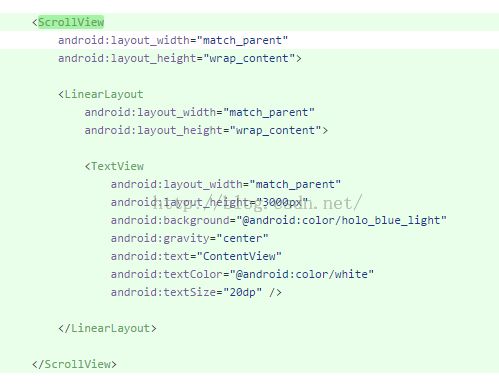学学下拉刷新
推荐
http://android-ultra-ptr.liaohuqiu.net/cn/
第一步 布局
因为用的都是 LinearLayout 和 FrameLayout,所以习惯于认为 Parent View 应该包含 Child View。
但这里的 PullLayout 不是。
public class PullLayout extends ViewGroup {
public PullLayout(Context context) {
super(context);
}
public PullLayout(Context context, AttributeSet attrs) {
super(context, attrs);
}
public PullLayout(Context context, AttributeSet attrs, int defStyleAttr) {
super(context, attrs, defStyleAttr);
}
// 总偏移量
int offset = 0;
View header;
View content;
@Override
protected void onFinishInflate() {
// 获取 header 和 content
header = getChildAt(0);
content = getChildAt(1);
super.onFinishInflate();
}
@Override
protected void onMeasure(int widthMeasureSpec, int heightMeasureSpec) {
// 默认处理
super.onMeasure(widthMeasureSpec, heightMeasureSpec);
measureChildren(widthMeasureSpec, heightMeasureSpec);
Log.e("result", "onMeasure");
}
@Override
protected void onLayout(boolean changed, int l, int t, int r, int b) {
layoutHeaderView();
layoutContentView();
Log.e("result", "PullLayout: " + l + " " + t + " " + r + " " + b + " ");
}
private void layoutHeaderView() {
final int left = 0;
final int top = offset - header.getMeasuredHeight();
final int right = left + header.getMeasuredWidth();
final int bottom = top + header.getMeasuredHeight();
header.layout(left, top, right, bottom);
Log.e("result", "header: " + left + " " + top + " " + right + " " + bottom + " ");
}
private void layoutContentView() {
final int left = 0;
final int top = offset;
final int right = left + content.getMeasuredWidth();
final int bottom = top + content.getMeasuredHeight();
content.layout(left, top, right, bottom);
Log.e("result", "content: " + left + " " + top + " " + right + " " + bottom + " ");
}
}ContentView 贴着 PullLayout 的左上角,HeaderView 则隐藏在上方,没有被绘制。
<FrameLayout xmlns:android="http://schemas.android.com/apk/res/android"
android:layout_width="match_parent"
android:layout_height="match_parent"
android:padding="50px">
<ivolianer.pulllayout.PullLayout
android:id="@+id/pullLayout"
android:layout_width="match_parent"
android:layout_height="match_parent"
android:background="@android:color/holo_red_light">
<TextView
android:layout_width="match_parent"
android:layout_height="300px"
android:background="@android:color/holo_blue_dark"
android:gravity="center"
android:text="HeaderView"
android:textColor="@android:color/white"
android:textSize="20dp" />
<TextView
android:layout_width="match_parent"
android:layout_height="1200px"
android:background="@android:color/holo_blue_light"
android:gravity="center"
android:text="ContentView"
android:textColor="@android:color/white"
android:textSize="20dp" />
</ivolianer.pulllayout.PullLayout>
</FrameLayout>

如果调整下 mScrollY,可以看到 HeaderView 是确实存在的。
PullLayout pullLayout = (PullLayout)findViewById(R.id.pullLayout);
pullLayout.setScrollY(-200);

日志:
04-11 11:28:12.601 28676-28676/ivolianer.pulllayout E/result: onMeasure04-11 11:28:12.601 28676-28676/ivolianer.pulllayout E/result: PullLayout: 50 50 1030 1651
04-11 11:28:12.601 28676-28676/ivolianer.pulllayout E/result: header: 0 -300 980 0
04-11 11:28:12.601 28676-28676/ivolianer.pulllayout E/result: content: 0 0 980 1200
第二步 拖拽和完善
假设暂时由 PullLayout 处理所有的事件。
float lastY;
@Override
public boolean dispatchTouchEvent(MotionEvent e) {
switch (e.getAction()) {
case MotionEvent.ACTION_DOWN:
break;
case MotionEvent.ACTION_MOVE:
// 滑动距离
float dy = e.getY() - lastY;
// 新的偏移量
int newOffset = (int) (offset + dy);
changeOffset(newOffset);
break;
case MotionEvent.ACTION_UP:
changeOffset(0);
break;
}
lastY = e.getY();
return true;
}
private void changeOffset(int offset) {
this.offset = offset;
// 会导致 onLayout 的调用
requestLayout();
}
已经能实现拖拽了,再来优化下。
比如 ContentView 不应被向上拖拽, HeaderView 不该拖拽离开 PullLayout 。
就是给 offset 加个大小的限制。
继续优化。
比如,松手后加上回弹动画。
比如,加上下拉的阻力。
比如,根据下拉距离选择执行加载动画,还是回弹动画。
比如,执行动画的过程,不应该接受到任何事件。
float lastY;
@Override
public boolean dispatchTouchEvent(MotionEvent e) {
// 执行动画过程,屏蔽所有事件
if (animating) {
return false;
}
switch (e.getAction()) {
case MotionEvent.ACTION_DOWN:
break;
case MotionEvent.ACTION_MOVE:
// 滑动距离
float dy = e.getY() - lastY;
// 阻力
dy = dy / 2;
// 新的偏移量
int newOffset = (int) (offset + dy);
newOffset = checkOffsetRange(newOffset);
changeOffset(newOffset);
break;
case MotionEvent.ACTION_UP:
if (offset > 280) {
doYourLoadingAnimation();
} else {
clearOffset();
}
break;
}
lastY = e.getY();
return true;
}
private void changeOffset(int offset) {
this.offset = offset;
// 会导致 onLayout 的调用
requestLayout();
}
private int checkOffsetRange(int newOffset) {
newOffset = Math.min(300, newOffset);
newOffset = Math.max(0, newOffset);
return newOffset;
}
//
boolean animating = false;
private void doYourLoadingAnimation() {
// 缩放动画
ValueAnimator animator = ValueAnimator.ofFloat(0.9f, 1.1f, 0.9f, 1.1f, 0.9f, 1.1f, 0.9f, 1.1f, 1);
animator.setDuration(2000);
animator.addUpdateListener(new ValueAnimator.AnimatorUpdateListener() {
@Override
public void onAnimationUpdate(ValueAnimator animator) {
float scale = (Float) animator.getAnimatedValue();
header.setScaleX(scale);
if (1 == animator.getAnimatedFraction()) {
animating = false;
clearOffset();
}
}
});
animator.start();
animating = true;
}
private void clearOffset() {
ValueAnimator animator = ValueAnimator.ofInt(offset, 0);
animator.setDuration(300);
animator.addUpdateListener(new ValueAnimator.AnimatorUpdateListener() {
@Override
public void onAnimationUpdate(ValueAnimator animator) {
int currentOffset = (Integer) animator.getAnimatedValue();
changeOffset(currentOffset);
if (1 == animator.getAnimatedFraction()) {
animating = false;
}
}
});
animator.start();
animating = true;
}
第三步 和 ContentView 分享事件
之前的 Content 是个 TextView ,现在换成 ScrollView。
ScrollView 失去了它一切的特性,不能滚动 ,不能 fling,因为所有的事件都被 PullLayout 消费拦截,没有进一步分发下去。
@Override
public boolean dispatchTouchEvent(MotionEvent e) {
// 执行动画过程,屏蔽所有事件
if (animating) {
return false;
}
boolean result = true;
switch (e.getAction()) {
case MotionEvent.ACTION_DOWN:
// 把事件分发下去,但始终消费 DOWN 事件
super.dispatchTouchEvent(e);
break;
case MotionEvent.ACTION_MOVE:
// 滑动距离
float dy = e.getY() - lastY;
Log.e("result","" + dy);
// 阻力
dy = dy / 2;
// 最难的地方,谁来处理滑动事件
if (offset > 0 || offset == 0 && dy > 0 && content.getScrollY() == 0) {
selfHandleMoveEvent(dy);
} else {
// 坑,千万不要用 return ,lastY 的每次赋值都很重要... 否则会突然滑动一段距离什么的...
result = contentHandleMoveEvent(e);
}
break;
case MotionEvent.ACTION_UP:
// 把事件分发下去,但始终消费 UP 事件
super.dispatchTouchEvent(e);
if (offset > 280) {
doYourLoadingAnimation();
} else {
clearOffset();
}
break;
}
lastY = e.getY();
return result;
}
private void selfHandleMoveEvent(float dy) {
int newOffset = (int) (offset + dy);
newOffset = checkOffsetRange(newOffset);
changeOffset(newOffset);
}
private boolean contentHandleMoveEvent(MotionEvent e) {
return super.dispatchTouchEvent(e);
}
难点在在于,何时让 PullLayout 响应移动事件,何时让 Content 响应移动事件。
if (offset > 0 || offset == 0 && dy > 0 && content.getScrollY() == 0) {offset > 0,说明是一个拖拽 Header 的过程,无论向上向下。
offset == 0 && dy > 0 && mContent.getScrollY() == 0offset == 0 header 完全隐藏, dy > 0 下拉拖拽。
mContent.get ScrollY() == 0,滚动条已经滚动到头部了,不需要再消费 MOVE 事件了。
